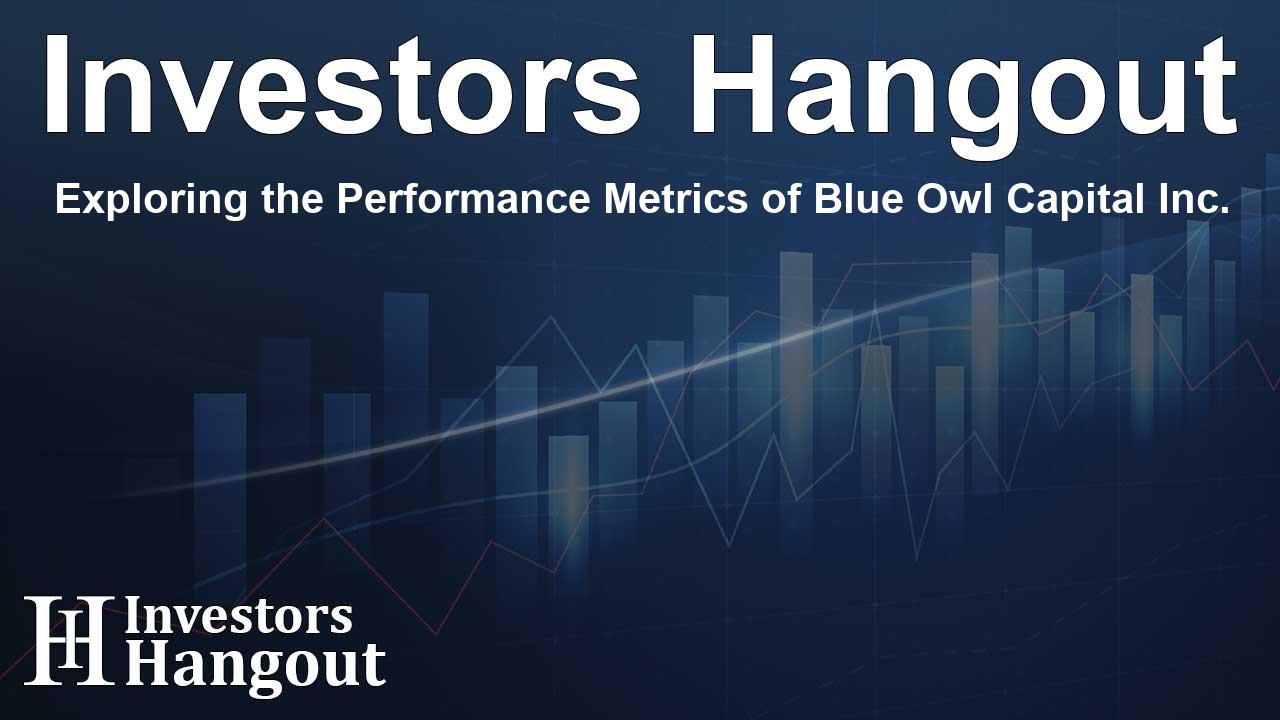Exploring the Performance Metrics of Blue Owl Capital Inc.

Understanding the Current Landscape of Blue Owl Capital
As we assess the current trading session, Blue Owl Capital Inc. (NYSE: OWL) shares are positioned at $21.71, reflecting a 0.28% dip. Notably, the stocks have faced an 18.18% decrease over the past month, yet a commendable 17.96% increase is observed over the last year. With these mixed short-term results and a stronger long-term performance, it's a crucial time for long-term investors to evaluate the company's price-to-earnings (P/E) ratio.
Deciphering the Importance of P/E Ratio
The price-to-earnings ratio serves as a key metric that compares a company’s current share price with its earnings per share (EPS). This analysis tool is invaluable for long-term investors aiming to measure Blue Owl Capital’s performance against its past earnings while also correlating historical data and industry averages like the S&P 500. A heightened P/E suggests that investors have higher expectations for the company’s future performance. This can indicate that the stock might be overvalued or that investors are ready to absorb a larger share price due to anticipated growth and augmented dividends in forthcoming quarters.
Blue Owl Capital Compared to Industry Peers
Currently, Blue Owl Capital boasts a P/E ratio of 108.85, significantly exceeding the average of 28.8 within the Capital Markets industry. This ratio might lead potential investors to believe that Blue Owl is set to outperform its industry counterparts in the near future. However, a closer look reveals that this higher ratio could also indicate a prevailing overvaluation of the stock.
Limitations of Relying Solely on P/E Ratio
While the P/E ratio is a potent tool for gauging a company’s market standing, its usage should not be without scrutiny. A lower P/E could signify an undervaluation of the stock; conversely, it may point to a lack of expected growth among shareholders. Thus, the P/E ratio should never be the only figure guiding investment decisions. Instead, it should be integrated with other financial indicators and qualitative analyses to cultivate a holistic understanding of the company's positioning.
The Bigger Picture: Long-term Strategies
Investors are constantly on the lookout for promising growth avenues. With Blue Owl Capital Inc. displaying a strong long-term trajectory, it’s essential for potential shareholders to delve deeply into both quantitative metrics like the P/E ratio and qualitative factors affecting growth. Understanding market dynamics, industry shifts, and the broader economic landscape will enable subscribers to make informed decisions regarding their investment strategies.
Final Thoughts on Investment in Blue Owl Capital
In wrapping up, the analysis of Blue Owl Capital through its P/E ratio provides a glance into its market potential. While the high P/E ratio may stump some investors, indicating growth expectations, it is pivotal to approach such valuations with an understanding of the broader market. With careful analysis and consideration of both quantitative and qualitative information, prospective investors will find it easier to navigate the complexities of investing in Blue Owl Capital Inc.
Frequently Asked Questions
What does the P/E ratio indicate about Blue Owl Capital?
The P/E ratio reflects the market's expectations for future growth and profitability, suggesting that investors may anticipate significant performance improvements.
How does Blue Owl's P/E ratio compare to the industry average?
Blue Owl Capital’s P/E ratio of 108.85 far surpasses the industry average of 28.8, raising questions about valuation but also indicating strong growth expectations.
Why is the P/E ratio significant for investors?
The P/E ratio helps investors gauge a company’s current share price concerning its earnings, making it easier to evaluate performance relative to its historical data and industry benchmarks.
Can a high P/E ratio imply overvaluation?
Yes, a high P/E ratio can suggest that a stock is overvalued, potentially leading to lower returns if the company's growth does not meet investor expectations.
What should investors consider beyond the P/E ratio?
Investors should look at other financial metrics, industry trends, market conditions, and qualitative insights to make well-rounded investment decisions.
About The Author
Contact Evelyn Baker privately here. Or send an email with ATTN: Evelyn Baker as the subject to contact@investorshangout.com.
About Investors Hangout
Investors Hangout is a leading online stock forum for financial discussion and learning, offering a wide range of free tools and resources. It draws in traders of all levels, who exchange market knowledge, investigate trading tactics, and keep an eye on industry developments in real time. Featuring financial articles, stock message boards, quotes, charts, company profiles, and live news updates. Through cooperative learning and a wealth of informational resources, it helps users from novices creating their first portfolios to experts honing their techniques. Join Investors Hangout today: https://investorshangout.com/
The content of this article is based on factual, publicly available information and does not represent legal, financial, or investment advice. Investors Hangout does not offer financial advice, and the author is not a licensed financial advisor. Consult a qualified advisor before making any financial or investment decisions based on this article. This article should not be considered advice to purchase, sell, or hold any securities or other investments. If any of the material provided here is inaccurate, please contact us for corrections.
